Osculum Study guides, Class notes & Summaries
Looking for the best study guides, study notes and summaries about Osculum? On this page you'll find 42 study documents about Osculum.
All 42 results
Sort by
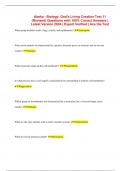
-
Abeka - Biology: God's Living Creation Test 11 (Revised) Questions with 100% Correct Answers | Latest Version 2024 | Expert Verified | Ace the Test
- Exam (elaborations) • 8 pages • 2024
- Available in package deal
-
- $8.49
- + learn more
What group includes snails, slugs, conchs, and nudibrancks? Gastropods What sessile animals are characterized by spicules, incurrent pores, an osculum, and no nervous system? Sponges What molecules make up the cell membrane? Phospholipids In what process does a cell engulf a solid particle by surrounding it with the cell membrane? Phagocytosis Which group of invertebrates are characterized by a muscular foot, a visceral hump, and a mantle? Mollusks What are the only animals with a water-...
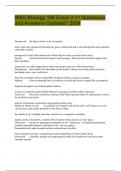
-
WSU Biology 106 Exam 3 >> Questions and Answers Updated | 2024
- Exam (elaborations) • 14 pages • 2024
-
- $12.49
- + learn more
WSU Biology 106 Exam 3 >> Questions and Answers Updated | 2024 Spongocoel the large central cavity of sponges. water enters the spongocoel through tiny pores called ostia and it exits through the large opening called the osculum. spongocoel is lined with choanocytes which help to create a current in the water. Spicule structural elements found in most sponges. They provide structural support and deter predators. Large ones are called megascleres while microscopic ones...
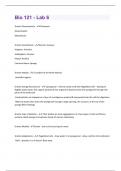
-
Bio 121 - Lab 6 exam (100% correct and graded A+)
- Exam (elaborations) • 6 pages • 2023
- Available in package deal
-
- $3.49
- + learn more
Grantia Characteristics - Eukaryotic Heterotrophic Multicellular Grantia Classification - Domain: Eukarya Kingdom: Animalia Subkingdom: Parazoa Phylum Porifera Common Name: Sponge Grantia Habitat - -Coastline of the North Atlantic -Intertidal regions Grantia Energy/Food Source - -Spongocoel - internal cavity lined with flagellated cells - beating of flagella draws water, fine organic particles & tiny organisms (bacteria) into the spongocoel through tiny pores of the body wall -Food ...
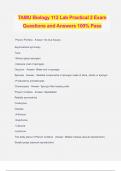
-
TAMU Biology 112 Lab Practical 2 Exam Questions and Answers 100% Pass
- Exam (elaborations) • 23 pages • 2024
- Available in package deal
-
- $13.49
- + learn more
TAMU Biology 112 Lab Practical 2 Exam Questions and Answers 100% Pass Phylum Porifera - Answer- No true tissues Asymmetrical symmetry Taxa: -Silicea (glass sponges) -Calcarea (rest of sponges) Osculum - Answer- Water exit in sponges Spicules - Answer- -Skeletal components of sponges made of silica, calcite or spongin -Produced by amoebocytes Choanocytes - Answer- Spong's filter-feeding cells Phylum Cnidaria - Answer- Diploblastic Radially symmetrical Cnidocytes Classes: -Anthozoa...
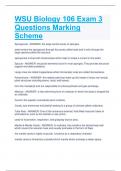
-
WSU Biology 106 Exam 3 Questions Marking Scheme
- Exam (elaborations) • 18 pages • 2023
-
- $13.49
- + learn more
WSU Biology 106 Exam 3 Questions Marking Scheme Spongocoel - ANSWER- the large central cavity of sponges. water enters the spongocoel through tiny pores called ostia and it exits through the large opening called the osculum. spongocoel is lined with choanocytes which help to create a current in the water. Spicule - ANSWER- structural elements found in most sponges. They provide structural support and deter predators. Large ones are called megascleres while microscopic ones are calle...
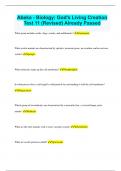
-
Abeka - Biology: God's Living Creation Test 11 (Revised) Already Passed
- Exam (elaborations) • 8 pages • 2024
- Available in package deal
-
- $9.99
- + learn more
Abeka - Biology: God's Living Creation Test 11 (Revised) Already Passed What group includes snails, slugs, conchs, and nudibrancks? Gastropods What sessile animals are characterized by spicules, incurrent pores, an osculum, and no nervous system? Sponges What molecules make up the cell membrane? Phospholipids In what process does a cell engulf a solid particle by surrounding it with the cell membrane? Phagocytosis Which group of invertebrates are characterized by a muscular fo...
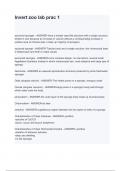
-
Invert zoo lab prac 1 questions and answers
- Exam (elaborations) • 6 pages • 2024
-
- $7.99
- + learn more
asconoid sponges - ANSWER-have a simple vase-like structure with a single osculum, limited in size because an increase in volume without a corresponding increase in surface area of choanocytes ( make up majority of sponges) syconoid sponge - ANSWER-Tubular body and a single osculum, the choanocyte layer is folded back and forth to make canals leuconoid sponges - ANSWER-more complex design, no real atrium, several small flagellated chambers instead in which choanocytes are, most adaptive an...
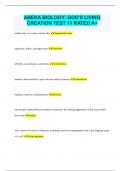
-
ABEKA BIOLOGY: GOD'S LIVING CREATION TEST 11 RATED A+
- Exam (elaborations) • 8 pages • 2024
- Available in package deal
-
- $9.99
- + learn more
ABEKA BIOLOGY: GOD'S LIVING CREATION TEST 11 RATED A+ earthworms, sea worms, and leeches segmented worms planarians, flukes, and tapeworms flatworms jellyfish, sea anemones, and hydras coelenterates animals characterized by spiny skin and radial symmetry echinoderms euglenas, amoebas, and paramecia protozoa microscopic multicellular invertebrates named for the rotating appearance of the cilia on their front ends rotifers what consists of stacks of flattened, membrane-encl...
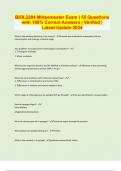
-
BIOL2204 Midsemester Exam | 55 Questions with 100% Correct Answers | Verified | Latest Update 2024
- Exam (elaborations) • 7 pages • 2023
-
- $10.49
- + learn more
What is the working definition of an animal? - Animals are multicellular eukaryotes that are heterotrophic and undergo a blastula stage Two problems associated with morphological classification? - 1. Convergent evolution 2. Minor mutations Why was the organism found in the 90s labelled as a bivalve mollusc? - Because it was consuming bivalve eggs and had traces of their DNA in its gut. What are some problems with molecular sequencing? - 1. Differences in mitochondrial and nuclear DNA ...
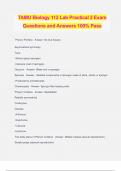
-
TAMU Biology 112 Lab Practical 2 Exam Questions and Answers 100% Pass
- Exam (elaborations) • 23 pages • 2024
- Available in package deal
-
- $12.49
- + learn more
TAMU Biology 112 Lab Practical 2 Exam Questions and Answers 100% Pass Phylum Porifera - Answer- No true tissues Asymmetrical symmetry Taxa: -Silicea (glass sponges) -Calcarea (rest of sponges) Osculum - Answer- Water exit in sponges Spicules - Answer- -Skeletal components of sponges made of silica, calcite or spongin -Produced by amoebocytes Choanocytes - Answer- Spong's filter-feeding cells Phylum Cnidaria - Answer- Diploblastic Radially symmetrical Cnidocytes Classes: -Anthozoa...



